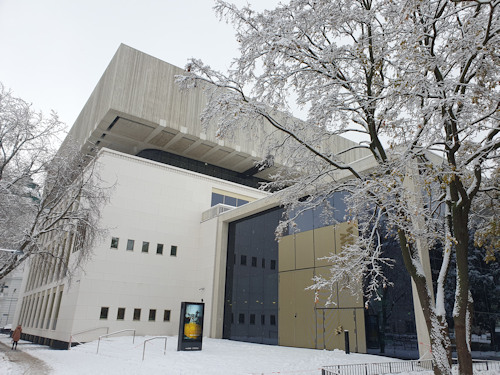Until they invent time travel, nothing beats the Wien Museum on Karlsplatz for a journey into the past. An all-new building and exhibition takes you through the history of Vienna and its people.
- Lovely, modern ambience and design
- Over 1700 objects in the (free) permanent exhibition
- Combines history with current perspectives
- Be sure to go onto the terrace for the views
- What special exhibitions are on?
- All info also in English
- See also:
A city’s journey
(One side of the museum on the wintry day it reopened)
Early December 2023 saw the reopening of the main Wien Museum on Karlsplatz after a long closure for major redevelopment of both the building and the permanent exhibition within.
Remarkably, they completed all the work to plan, on time and on budget, despite the various public health and inflation issues of the construction years. But the big question for us, of course, is…was it worth it?
Spoiler: yes. We have a new jewel in the city’s museum landscape.
At its core, the Wien Museum presents the history of Vienna (the city and community) in three floors.
We discover the art and the achievements, but also the darker times.
We explore lives, events and movements. Witness the exceptional and the banal.
And browse over 1700 newly-renovated objects: all united by their association with a former Imperial capital that has a long entry in the chronicles of human civilisation.
The Permanent Exhibition
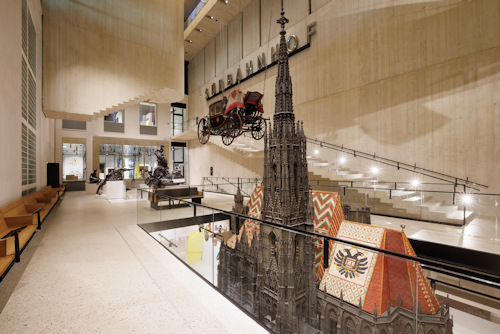
(The exhibition atrium with the giant model of Stephansdom cathedral; press photo by Lisa Rastl © Wien Museum)
The Vienna. My history exhibition takes you on a chronological journey through 13 chapters. You begin at the Paleolithic era with a mammoth tusk and end in the current day with a backpack from a food delivery service.
Roman encampments, Gothic cathedrals, Habsburg monarchs, Ottoman sieges, Nazis, Red Vienna, the Wiener Moderne and more all feature.
The displays go beyond just history to draw in art, culture, economics, social issues, urban development and even natural history (including an itinerant giant whale sculpture that once graced the insides of the Zum Walfisch restaurant in the Prater).
Something for everyone and plenty of interactive hands-on elements for kids, too.
A journey full of change, yet always presented with a thread of continuity and parallels between past and present.
I’m working on a more detailed article on the exhibition itself, but here some personal highlights:
Art
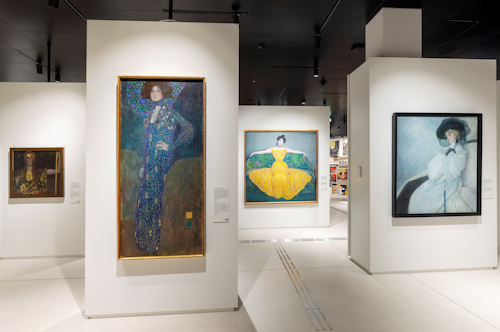
(Klimt, Kurzweil and others in the Fin-de-siècle Vienna chapter; press photo by Lisa Rastl © Wien Museum)
You might almost consider this an art museum inside a history museum. The cityscapes in oils, etchings, watercolours and engravings bring the past to life and allow comparisons across the decades.
And then we have the famous artists, with works by the likes of Gustav Klimt, Egon Schiele, Richard Gerstl, Auguste Rodin, Otto Wagner, Rudolf von Alt, Friedrich von Amerling, and Ferdinand Georg Waldmüller…among many others.
We can, of course, appreciate the many oil paintings for their artistic quality, but also understand their marketing or even propaganda value; disinformation did not begin with social media. As such, not all the displayed works make for comfortable viewing.
For example, the numerous Nazi banners in Igo Pötsch’s 1940 painting of Heldenplatz square and The Führer Travelling to the Proclamation on March 15th, 1938 feel like scars on the city’s character.
Models & installations
I love the giant models of Vienna at different time periods, not to mention a huge replica of Stephansdom cathedral built in the 1800s (with a periscope to see inside).
One large atrium also has the original statues from the 18th-century Donnerbrunnen fountain you can see on Neuer Markt square (home to one of my favourite cafés).
Connections & commentary
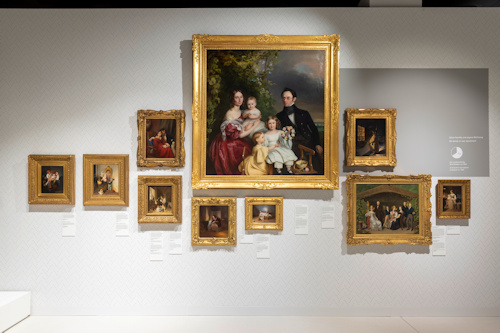
(Despite these paintings, it’s not all about domestic bliss in the Wien Museum; press photo by Lisa Rastl © Wien Museum)
History is anything but dry here, as the exhibition constantly draws out links to current issues and times.
So you discover a long tradition of moving to where the work is: Roman soldiers assigned to Vindobona (Vienna’s Latin name) came from the British Isles, Arabia, North Africa and throughout Europe.
Six dedicated visitor stations actually invite you to consider specific parallels between the past and today. Medieval guilds restricted access to certain occupations, for example. Today we have more subtle glass ceilings.
I particularly value an approach that goes beyond the usual areas of emphasis.
Many places in Vienna have a laser-like focus on emperors and empresses. Understandable, of course, and the Wien Museum has its paintings of Imperial personalities, too. But the servants also get attention.
The museum, for example, invites us to admire the monumental construction era of the late 1800s that gave rise to the Ring and all its glories. But we also learn of the workers who built the famous buildings and the conditions under which they lived.
Expect some excellent temporary exhibitions, too, covering artistic, sociocultural and contemporary themes.
The building itself
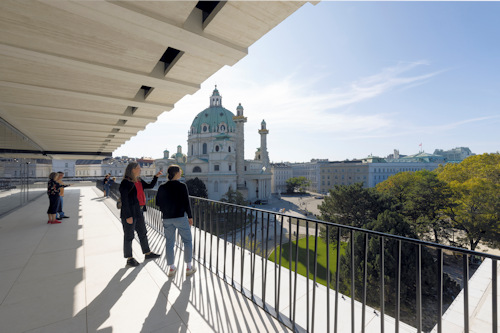
(View of Karlskirche church from the Wien Museum terrace; press photo by Lisa Rastl © Wien Museum)
The redevelopment means the Wien Museum oozes style and space.
No sweeping staircases and golden ornamentation. But the compensation is a next-generation airy, modern museum with room to breathe. And all carrying the Austrian Ecolabel. Both the building and permanent exhibition are designed for accessibility that goes far beyond the usual.
Be sure to go out onto the terrace, which gives you views across the park to the neighbouring Karlskirche church, Musikverein, Konzerthaus and other landmarks. In winter, dusk should provide a gorgeous outlook across the Art Advent Christmas market below.
Tickets, exhibitions & tips
Unusually for Vienna and the wider German-speaking world, basic museum entry is free. This includes the permanent exhibition. You only pay to access any special exhibition that might be on.
Special exhibitions
The current schedule for the main ticketed exhibition area is:
- Controlled Freedom (until September 7th, 2024): life in post-WWII Vienna and the cultural efforts of the Allied forces in Vienna
Next up:
- Reinforced Concrete (May 22nd to September 28th, 2025): how a revolutionary technology changed the face (literally) of Vienna around 1900
The official website also offers a free digital guide to the permanent exhibition in English you can access via your smartphone’s web browser. No app needed.
The museum has the fully-fledged Trude restaurant (also open late at night) on the ground floor and a self-service café-bar (a certain summer hit) adjoining the terrace inside the main museum itself.
Vienna has other options for exploring specific aspects of its history outside the Wien Museum. Continue your journey with these articles, for example:
- Overviews on historical eras: the Habsburg dynasty, the Ottoman siege of 1683, Baroque Vienna, the Biedermeier, the Wiener Moderne and Jugendstil
- Imperial life: visit the Hofburg and Schönbrunn palace complexes
How to get there
You would struggle to pick an easier location to reach. The Wien Museum occupies the NE corner of the Karlsplatz area, which has its own subway station. Take the U1, U4 or U2 to Karlsplatz station and look for the Resselpark exit.
Alternatively, take a short walk from nearby tram stops. For example: Gußhausstraße (line D), Schwarzenbergplatz (lines D, 2, 71) and Oper/Karlsplatz (lines 1, 2, D, 71, 62)
Address: Karlsplatz 8, 1040 Vienna | Website

